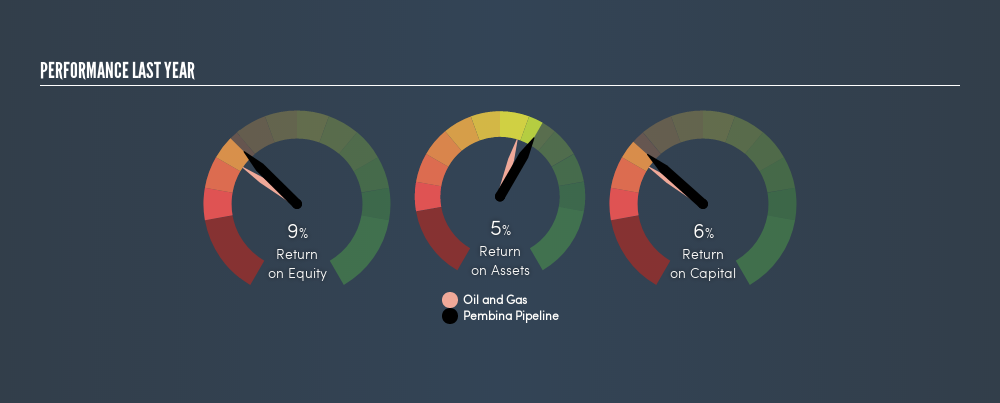- Canada
- /
- Oil and Gas
- /
- TSX:PPL
Evaluating Pembina Pipeline Corporation’s (TSE:PPL) Investments In Its Business

Want to participate in a short research study? Help shape the future of investing tools and you could win a $250 gift card!
Today we'll look at Pembina Pipeline Corporation (TSE:PPL) and reflect on its potential as an investment. Specifically, we'll consider its Return On Capital Employed (ROCE), since that will give us an insight into how efficiently the business can generate profits from the capital it requires.
First up, we'll look at what ROCE is and how we calculate it. Then we'll compare its ROCE to similar companies. Then we'll determine how its current liabilities are affecting its ROCE.
Understanding Return On Capital Employed (ROCE)
ROCE measures the 'return' (pre-tax profit) a company generates from capital employed in its business. In general, businesses with a higher ROCE are usually better quality. In brief, it is a useful tool, but it is not without drawbacks. Renowned investment researcher Michael Mauboussin has suggested that a high ROCE can indicate that 'one dollar invested in the company generates value of more than one dollar'.
How Do You Calculate Return On Capital Employed?
Analysts use this formula to calculate return on capital employed:
Return on Capital Employed = Earnings Before Interest and Tax (EBIT) ÷ (Total Assets - Current Liabilities)
Or for Pembina Pipeline:
0.062 = CA$1.6b ÷ (CA$27b - CA$1.5b) (Based on the trailing twelve months to March 2019.)
Therefore, Pembina Pipeline has an ROCE of 6.2%.
View our latest analysis for Pembina Pipeline
Does Pembina Pipeline Have A Good ROCE?
When making comparisons between similar businesses, investors may find ROCE useful. It appears that Pembina Pipeline's ROCE is fairly close to the Oil and Gas industry average of 5.5%. Setting aside the industry comparison for now, Pembina Pipeline's ROCE is mediocre in absolute terms, considering the risk of investing in stocks versus the safety of a bank account. Readers may find more attractive investment prospects elsewhere.

Remember that this metric is backwards looking - it shows what has happened in the past, and does not accurately predict the future. ROCE can be misleading for companies in cyclical industries, with returns looking impressive during the boom times, but very weak during the busts. ROCE is only a point-in-time measure. Given the industry it operates in, Pembina Pipeline could be considered cyclical. Since the future is so important for investors, you should check out our free report on analyst forecasts for Pembina Pipeline.
Do Pembina Pipeline's Current Liabilities Skew Its ROCE?
Liabilities, such as supplier bills and bank overdrafts, are referred to as current liabilities if they need to be paid within 12 months. The ROCE equation subtracts current liabilities from capital employed, so a company with a lot of current liabilities appears to have less capital employed, and a higher ROCE than otherwise. To counteract this, we check if a company has high current liabilities, relative to its total assets.
Pembina Pipeline has total liabilities of CA$1.5b and total assets of CA$27b. Therefore its current liabilities are equivalent to approximately 5.6% of its total assets. Pembina Pipeline reports few current liabilities, which have a negligible impact on its unremarkable ROCE.
The Bottom Line On Pembina Pipeline's ROCE
If performance improves, then Pembina Pipeline may be an OK investment, especially at the right valuation. Of course, you might find a fantastic investment by looking at a few good candidates. So take a peek at this free list of companies with modest (or no) debt, trading on a P/E below 20.
If you are like me, then you will not want to miss this free list of growing companies that insiders are buying.
We aim to bring you long-term focused research analysis driven by fundamental data. Note that our analysis may not factor in the latest price-sensitive company announcements or qualitative material.
If you spot an error that warrants correction, please contact the editor at editorial-team@simplywallst.com. This article by Simply Wall St is general in nature. It does not constitute a recommendation to buy or sell any stock, and does not take account of your objectives, or your financial situation. Simply Wall St has no position in the stocks mentioned. Thank you for reading.
About TSX:PPL
Established dividend payer and fair value.
Similar Companies
Market Insights
Community Narratives



